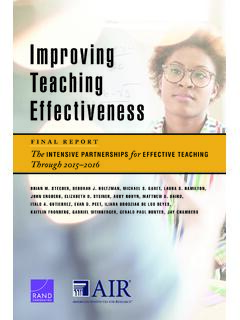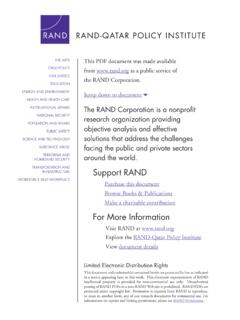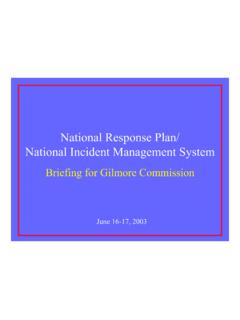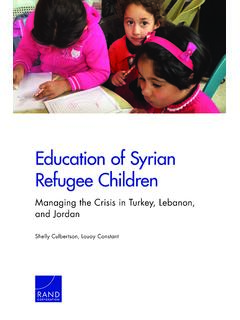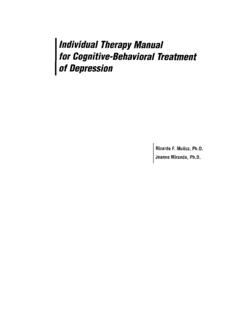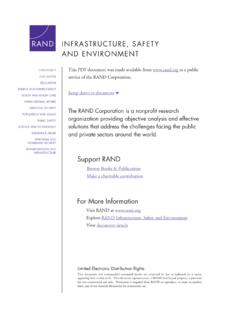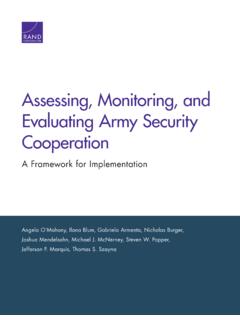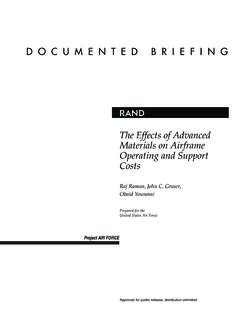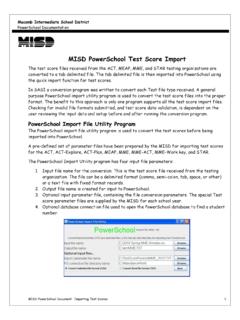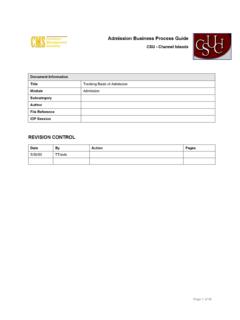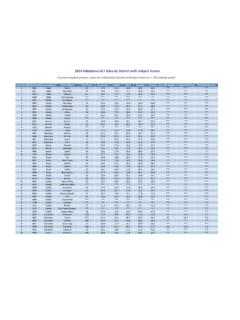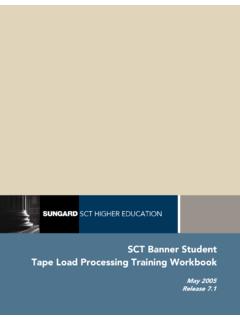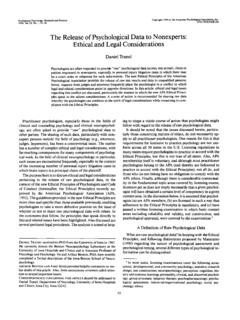Transcription of Using Test-Score Data in the Classroom - rand.org
1 Using Test-Score data in the Classroom BRIAN M. STECHER AND LAURA S. HAMILTON WR-375-EDU April 2006 WORKING P A P E R This product is part of the rand Education working paper series. rand working papers are intended to share researchers latest findings and to solicit informal peer review. They have been approved for circulation by rand Education but have not been formally edited or peer reviewed. Unless otherwise indicated, working papers can be quoted and cited without permission of the author, provided the source is clearly referred to as a working paper. rand s publications do not necessarily reflect the opinions of its research clients and sponsors.
2 Is a registered trademark. - iii - -Preface Teachers and principals have access to Test-Score data from a variety of sources, including state accountability tests , and the success of test based accountability policies, like No Child Left Behind (NCLB), in raising student achievement will be strongly influenced by their use of these data to guide school policy and Classroom practice. As part of a larger study of NCLB implementation, we surveyed (and, in a small number of cases, interviewed) elementary and middle school principals and mathematics teachers in three states to obtain information on the formats in which they received Test-Score data , their opinions about the quality of the data , the ways in which they used these data , and conditions that hindered or promoted effective use.
3 This paper provides a descriptive summary of these data . The findings should provide insights for improving the utility of Test-Score information at the Classroom level, and for improving the validity of large-scale testing systems more generally. This material is based on work supported by the National Science Foundation under Grant No. REC-0228295. Any opinions, findings, and conclusions or recommendations expressed in this material are those of the author(s) and do not necessarily reflect the views of the National Science Foundation. This paper was presented as part of the related paper session, Using Assessment Results to Improve District and School Practices, at the annual meeting of the National Council on Measurement in Education, April 2006.
4 - v - iii vii Background .. 1 ISBA Study Methods .. 4 6 How Do Teachers Use Test Results?.. 7 What Factors Influence Test Use? .. 14 Elementary 15 Middle School Teachers .. 15 Examining Variation in data Use and its Correlates .. 28 Discussion .. 29 35 - vii - -TablesTable 1. Sample Sizes for Survey Responses .. 5 Table 2. Percent of Mathematics Teachers Engaged in Selected Assessment-Related Activities Often During the 2004-05 School Year .. 8 Table 3. Percent of Mathematics Teachers Engaged in Selected Assessment-Related Activities More Frequently in 2004-05 Than in 2003-04 .. 9 Table 4. Percent of Mathematics Teachers Reporting They Engage in Practices A Moderate Amount or A Great Deal as a Result of Mathematics Assessments, 2004-05.
5 10 Table 5. Percentage of Teachers Agreeing or Strongly Agreeing with Statements about the Use of State tests , 2004-05 .. 12 Table 6. Percentage of Principals Reporting that State Assessment data is Moderately or Very Useful for Making 13 Table 7. Percentage of Teachers Reporting Availability and Usefulness of Mathematics Test Result Summaries, 2004-05 .. 15 Table 8. Percentage of Principals Reporting Availability and Usefulness of Information and Assistance on 2003-04 State Test 16 Table 9. Percentage of Teachers Agreeing or Strongly Agreeing with Statements about the Features of the State tests , 2004-05 .. 17 Table 10. Percentage of Teachers Agreeing to Statements Regarding the Quality of the State Assessments, 20 Table 11.
6 Percentage of Teachers Reporting Availability and Usefulness of Resources and for Using Mathematics Test Results, 2004-05 .. 22 Table 12. Percentage of Teachers Reporting that Professional Development had a Moderate or Greater Emphasis on Selected Features, 2004-05 .. 23 Table 13. Percentage of Teachers Who Agree or Strongly Agree that Principal at Their School Engages in Selected Behaviors, 24 Table 14. Percentage of Principals Reporting That Assistance for data Use wasAvailable and Very Useful, 2004-05 .. 25 Table 15. Percent of Mathematics Teachers Reporting Progress tests with Various Features, 1 - -Introduction Background As a result of the No Child Left Behind Act (NCLB) of 2001, all states have implemented statewide testing programs in reading and mathematics for all students in grades 3 to 8 and for one high school grade.
7 Results are provided for every student (for use by schools and parents) and aggregated results are used to evaluate schools and districts. Under NCLB, severe negative consequences can accrue to schools and districts that repeatedly fail to make Adequate Yearly Progress (AYP). Given the high stakes attached to performance on these tests , it is important that states make sure they are reliable and valid for these purposes. Most states have taken extensive steps to evaluate the technical quality of their tests for judging the performance of students. However, for the most part states have not examined the effects of testing on educational practice.
8 This is an important omission because one of the central assumptions of NCLB is that the provision of high-quality information will promote improved educational decision-making (Stecher, Hamilton, & Gonzalez, 2003). For example, while describing the benefits of NCLB in a recent speech, President Bush stated, As well, we better figure out who needs help early before it's too late. I mean, one of the reasons you ask the question, can you read or write and add and subtract, is you want to diagnose early. You can't solve a problem unless you diagnose it. The importance of the No Child Left Behind Act is to find out who needs help ( ). Large-scale testing programs such as those mandated by NCLB are generally intended to send signals to - 2 - -practitioners (both in the form of score reports and in the form of institutional sanctions) about whether their practices are effective or not, and to provide evidence they can use to promote improved outcomes for students.
9 When tests are used explicitly for the purpose of shaping institutional behavior, as they are in the context of NCLB, validation requires further effort than most states have expended. In particular, states should monitor the consequences, both anticipated and unanticipated, of their testing programs (AERA, APA & NCME, 1999, Standard ). Research points to some of the consequences that high-stakes tests may have on district and school policies and practices (Corbett & Wilson, 1988; Hamilton, 2003; Koretz, Barron, Mitchell, & Stecher, 1996; Romberg, Zarinia, & Williams, 1989; Shepard & Dougherty, 1991; Stecher, Barron, Chun, & Ross, 2000; Pedulla et al.)
10 , 2003). However, relatively less is known about the use of this information for school and Classroom decision-making or the features of the results (such as their perceived quality) that influence their utility for these purposes. Effective use of Test-Score data for instructional decision-making is widely viewed as one of the most important actions districts and schools can take to promote improved student achievement (Council of Great City Schools, 2002; Massell, 2001). Past research provides guidance regarding the conditions necessary to support data use, such as high-quality principal leadership (Mason, 2002; Supovitz & Klein, 2003), adequate resources, including teacher planning time (Ingram et al.
